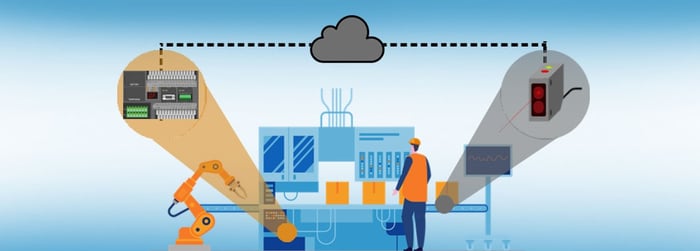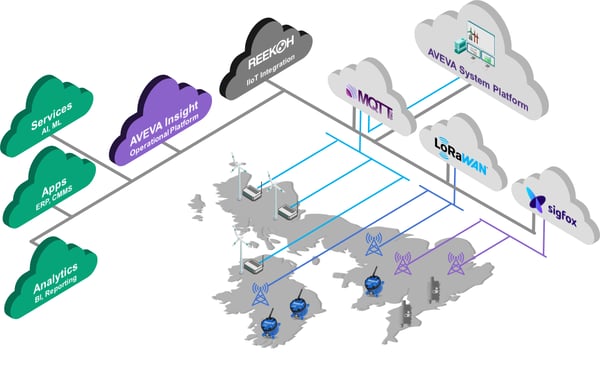In my previous blog, I discussed Industrial IoT, its potential and how it’s a key ingredient to accelerate digital transformation in our industry. Now, I want to look at the more practical IOT Use Cases. Smart Industrial IoT has many use cases and I’m going to focus on just a few.

Related Blog: IIoT Will NOT Improve Operational Performance!
The general idea behind Industrial IoT is to get stuck in quickly with the least amount of friction. If it takes weeks and months to set up, you’ve already lost the plot. You need to show results in days, not months! But how do you get started?
Industrial IoT in the Factory
IIoT has to work in harmony with the traditional automation system, rather than replace it (at least not in the near future). So, if it’s not going to replace it, how will it be of benefit? Let's look at an example.
Your business relies on production lines to run at a certain efficiency. You need to know if there’s any danger of not hitting your targets or if there’s something that might be adversely affecting the production process.
Now, you rely on the production staff on the floor to make sure everything is ticking along nicely. But they can’t be in more than one place at once. So, what can we do to help?
The traditional answer is we start a project that involves installing the right smart sensors, wiring them up and connecting them to an automation system like a PLC. Next, the software systems need to be configured and code changes have to be made to PLCs to accommodate the new smart sensors.
How are you going to capture this data and present it to users? More work is required to look for or write software that will do this. Don’t forget this software needs to run on computers - so you’re going to have to add those to the shopping list too. The next step is to write a user specification and go out on tender to get the work done.
It suddenly dawns on you that this is going to take some serious time, money and energy to get a project of this kind in place. What will the ROI be? At this stage, many companies realise it might just not be worth the effort.
But there's a better way! Industrial IoT to the rescue.
By installing a simple, non-intrusive edge IOT device on the plant floor that connects sensors to the existing machines automation system, then connecting it to a cloud service, we could have a solution up and running in days.
But what if you don't have the right IOT devices in place?
No problem - just hook up some low-cost IIoT sensors to something like a local LoRaWAN network and you’re ready to go. The great thing with LoRaWAN is you don’t need a costly wireless networking survey to be done and it provides sufficient penetration. A small base station goes a long way!
With the power of the cloud and ready-built smart services to manage OEE (Overall Equipment Effectiveness) and predictive maintenance, most of the work is done for you. Zero to hero in days!
But IIoT goes beyond that in the factory - it opens new possibilities. We can now connect systems that are traditionally outside of automation into a unified system and thereby avoid the siloed approach.
Environmental monitoring systems, building management systems (BMS), outside utilities or even third-party services and suppliers can be brought under one umbrella to enable companies to have a holistic view of their operations. Ultimately, this can extend to the entire supply chain - providing a real-time view of all facilities that form part of the enterprise.
IIoT for Geographically Dispersed Assets
In industries like infrastructure management, i.e. water, rail, power, facilities, it’s a challenge to manage many assets that are geographically distributed - sometimes on a global scale.
Proactive management of these assets is difficult and costly as a result. IIoT offers these industries a new and much more efficient way of managing their systems. The traditional approach has various considerations to keep in mind:
- Networking and cybersecurity concerns when connecting to remote sites are very costly to install and maintain. A VPN is the normal approach, but it comes with a huge overhead to manage.
- Communication drivers are notoriously complex to configure as there are normally substantial numbers of peer-to-peer communications to devices like RTUs that need to be maintained. It means you must make sure every device can be connected to.
- Scalability soon becomes an issue as systems reach their limits.
- But the biggest overhead is the continuous management of the system to make sure remote devices are up to date and communications are working.
So what does the smart Industrial IoT approach look like?
- All IOT devices send their data to a central server or broker using a single port outbound connection. No more peer to peer communication to manage.
- It can be done safely using the public or private cloud.
- Lightweight IIoT protocols like MQTT not only have minimal overhead but they also come encrypted and secure.
- IIoT was built for scalability and device management is built in.
Future Proof Solutions
Embracing Industrial IoT allows you to travel with confidence on your digital transformation journey as it’s now easy to integrate across your enterprise and supply chain, provided you use open web-based protocols. Take full advantage of:
- Intelligence services like AI (artificial intelligence) and ML (Machine Learning).
- Integration to ERP (Enterprise Resource Planning) and CMMS (Computerised Maintenance Management system) and many others that will help connect silos of information.
- Advanced data analytics and big data repositories will make sure data from across all systems is always safely stored and provided back to users with the right context.

The key to this is to have the right IOT technology and integration platform. SolutionsPT can help you on this journey, but you’ll need to get your toes wet first. Rome wasn’t built in a day.
Down with Downtime!
In our upcoming webinar, we explore the tools that enable you to achieve a more efficient workforce, with relevant data and knowledge of procedures at their fingertips, in any location. By using AVEVA solutions, you can empower staff to make faster and better decisions, powering productivity on production lines all over the world. Register for the webinar now by clicking the link below.
However, if you do want to waste any more time on downtime and would like to see it in action, simply sign up for a free 45 day trial.


